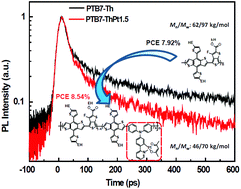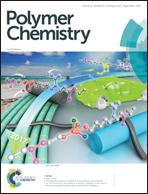Cyclometalated Pt complex-based random terpolymers for efficient polymer solar cells†
Abstract
Platinum complex was introduced in low ratios (0, 1, 1.5, and 5 mol%) as the third monomer in the conjugated backbone of well-known donor polymer PTB7-Th using a random terpolymer molecular design approach. All polymers showed similar absorption behavior and comparable HOMO/LUMO energy levels due to the small amount of Pt complex used. When blended with PC71BM in polymer solar cells, the power conversion efficiency was enhanced to 8.45% (obtained by the device based on PTB7-ThPt1.5 containing 1.5 mol% Pt) compared with 7.92% for the control PTB7-Th. Notably, the apparently low molecular weight of PTB7-ThPt1.5 (Mn/Mw: 46/70 kg mol−1) compared with that of PTB7-Th (Mn/Mw: 62/97 kg mol−1) ensured a more convincing comparison. Using a combination of physical measurements, such as optoelectrical characterization, grazing incident wide-angle X-ray diffraction (GIWAXS), and picosecond time-resolved photoluminescence, the efficiency enhancement was contributed by the higher hole mobility, less bimolecular recombination, and a more efficient slow charge separation process.



 Please wait while we load your content...
Please wait while we load your content...